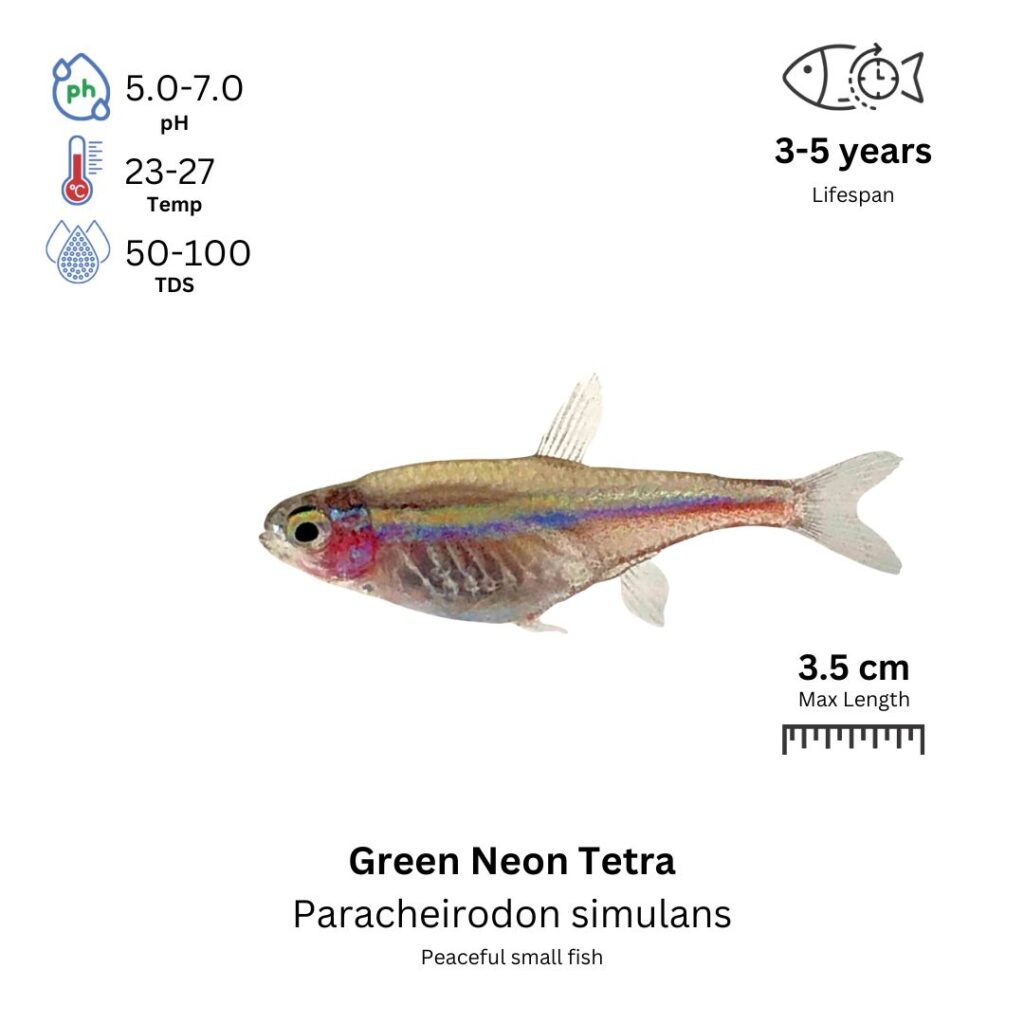Green Neon Tetra
Paracheirodon simulans

Description
The Green Neon Tetra is a small and vibrant species of tetra known for its striking coloration. Its body is a shimmering greenish-blue, with a bright iridescent strip running horizontally along the body from the head to the tail, which glows under the right lighting conditions. This strip is similar to the Neon Tetra but with a greenish tint rather than the classic blue. They have a slender, elongated body and are peaceful, social fish that are best kept in schools. Green Neon Tetras are active swimmers, often seen in the middle to upper parts of the tank, and their colorful display in groups makes them a popular choice for aquariums.
Habitat Origin
Native to the Rio Iguaçu in South America, particularly in Brazil, where they inhabit slow-moving rivers and streams with dense vegetation. They thrive in waters with low to moderate flow and a slightly acidic pH.
Aquarium
Ideal Number in Aquarium: At least 6 individuals, as they are schooling fish and feel more secure in groups.
Favorite Food

Green Neon Tetras are omnivores and will accept a variety of foods, including high-quality flake food, micro pellets, and live or frozen foods like brine shrimp, daphnia, and bloodworms. They will also feed on small plant matter, algae, and biofilm in the tank.
Behavior:
Green Neon Tetras are peaceful and non-aggressive. They are schooling fish and do best when kept in groups of at least 6, where they feel more secure and can display their natural social behavior. These fish are very active and often seen darting around the middle and upper sections of the tank. They are generally shy when alone but become more confident and vibrant when kept in schools. Green Neon Tetras are peaceful and get along well with other small, non-aggressive fish.
Special Care:
Green Neon Tetras do best in a well-planted aquarium with plenty of hiding spots, such as plants, rocks, and driftwood. They thrive in stable water conditions, so regular water changes and good filtration are necessary. They prefer slightly acidic water, which mimics their natural habitat. Care should also be taken not to expose them to strong currents or large, aggressive tankmates.
Compatibility with Other Fish:
Yes, they are excellent tankmates for other small, peaceful species like other tetras, rasboras, and shrimp. Due to their small size, they should be kept away from larger or more aggressive fish that may view them as food. Green Neon Tetras are best suited for peaceful community tanks with other small fish that share similar care requirements.
Breeding Tank Setup
Using a separate breeding tank is highly recommended for Green Neon Tetras to protect the eggs and fry from being eaten and to allow full control over water parameters. A 10-gallon (38-liter) tank is suitable for a small breeding group, while a 20-gallon (75-liter) tank is better for multiple pairs. Maintain water parameters at pH 5.5–7.0, temperature 24–28°C (75–82°F), and hardness 2–12 dGH. A sponge or internal filter is ideal to provide gentle aeration without strong currents. Use fine sand or gravel substrate, and add dense plants like Java moss and Hornwort, with floating plants like Water Sprite to give extra cover. Moderate lighting with a 10–12 hour light/dark cycle is sufficient, avoiding excessive brightness.
Conditioning Adults for Breeding
To condition Green Neon Tetras for spawning, feed them a high-protein, well-balanced diet over several days. This includes micro pellets or quality flakes, live or frozen foods such as brine shrimp, daphnia, and bloodworms, and occasional vegetable matter like blanched spinach or peas. Perform 25–30% weekly water changes to keep the environment clean. Just before breeding, do a 50% water change and raise the temperature slightly to around 28°C (82°F) to simulate the rainy season, a known trigger for spawning in tetras.
Spawning Process
Spawning typically occurs early in the morning, especially after a large water change. Males display their vibrant green coloration and swim close to the females. Females then scatter 30–100 small, sticky eggs, which adhere to plants, decorations, or the substrate. The spawning process can continue for several hours. After laying and fertilizing the eggs, remove the adults immediately, as Green Neon Tetras often consume their own eggs if left in the tank.
Fry Hatching & Early Care
Eggs will hatch within 24–36 hours, depending on the temperature. Fry remain motionless for a few days while consuming their yolk sacs. Once free-swimming, begin feeding infusoria or liquid fry food, then introduce baby brine shrimp, microworms, or crushed flakes as they grow. Maintain high water quality with daily 10–20% water changes and keep the temperature steady between 24–28°C. Avoid overfeeding, as decaying food can quickly foul the water and endanger the fry.
Additional Tips & Precautions
Green Neon Tetras reach breeding maturity at 6–12 months. Males are typically slimmer and more colorful, while females are rounder and slightly larger, especially when gravid. To maximize success, avoid stressors such as aggressive tank mates or sudden changes in water parameters. Clean, quiet conditions and a balanced diet are critical for both breeding and raising fry successfully.
